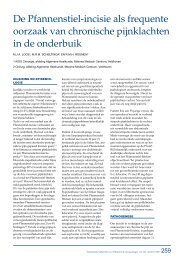Surgical management of chronic inguinal pain syndromes - Liespijn
Surgical management of chronic inguinal pain syndromes - Liespijn
Surgical management of chronic inguinal pain syndromes - Liespijn
You also want an ePaper? Increase the reach of your titles
YUMPU automatically turns print PDFs into web optimized ePapers that Google loves.
Outpatient assessmentAll patients with moderate or severe <strong>pain</strong> (n=61) as determined by the VRS-scoringsystem were eligible for follow up. As 29 patients did not participate in this assessmentfor reasons as stated in figure 2, a population <strong>of</strong> 32 patients was evaluated using anextensive interview and a physical examination. The demographic and clinical details<strong>of</strong> these patients are shown in table 1. This subgroup forms a representative portion <strong>of</strong>the entire population. Findings <strong>of</strong> <strong>pain</strong> history and physical examination are listed intable 4.n (%)Plan HistoryCharacterNeuropathic 23 (72)Non-neuropathic 9 (28)FrequencyOccasionally 2 (6)Regularly 12 (38)Always 20 (58)CourseConstant 22 (68)Intermittent 4 (13)Progressive 2 (6)Decreasing 4 (13)Other <strong>chronic</strong> <strong>pain</strong> <strong>syndromes</strong>** 23 (72)Physical examinationBulge 1 (3)NeurophysiologyNormal 14 (44)Hypoesthesia 14 (44)Hyperesthesia 3 (9)Allodynia 1 (3)Trigger point 17 (53)Nerve block (lidocain 1%) 9 (28)Significant <strong>pain</strong> reduction (10 minutes)*** 6 (18)Persisting total <strong>pain</strong> reduction (12 months) 2 (6)Table 4 Pain history and physical examination in patients who visited the outpatient department based on high <strong>pain</strong> scores(VRS = moderate or severe*, n=32).*VRS = Verbal Rating Scale, **Chronic <strong>pain</strong> <strong>syndromes</strong> = <strong>chronic</strong> headache, low back <strong>pain</strong>, complex regional <strong>pain</strong> syndrome,irritable bowel syndrome, *** Pain reduction following nerve block after 10 minutes and after 12 months.Neuropathic <strong>pain</strong> caused by an entrapment <strong>of</strong> the iliohypogastric or ilio<strong>inguinal</strong> nervewas present in 17 patients (17/32, 53%). Nine patients opted for a diagnostic nerve blockthat led to a significant <strong>pain</strong> reduction in six <strong>of</strong> them. The initial <strong>pain</strong> reduction persistedfor at least 12 months in two <strong>of</strong> these 6 patients. The remaining eight patients refusedinjection.A variety <strong>of</strong> non-neuropathic causes was diagnosed including non-specific diffuse scar<strong>pain</strong>. Bulges indicating incisional hernias were not found, although one patientpresented with bulging <strong>of</strong> the entire lower abdominal wall due to muscle atrophy. Twopatients complained <strong>of</strong> a ‘pulling’ <strong>pain</strong> confined to the midline which was classified asmusculotendinous in origin. Keloid formation and fat necrosis produced local scar <strong>pain</strong>in two other patients. Three additional patients were diagnosed by the gynaecologistwith endometriosis, secondary vaginism and primary dysmenorrhoea, respectively.A diagnostic classification <strong>of</strong> post-Pfannenstiel <strong>syndromes</strong> is proposed in table 5.n (%)1. Neuropathic 17 (53.1)2 Non-neuropathicNon-gynaecological- Diffuse scar <strong>pain</strong> 7 (21.9)- Musculotendinous 2 (6.3)- Abdominal wall atrophy with bulging 1 (3.1)- Keloid 1 (3.1)- Fat necrosis 1 (3.1)DISCUSSIONGynaecological- Endometriosis 1 (3.1)- Secondary vaginism 1 (3.1)- Dysmenorrhoea 1 (3.1)Table 5 Diagnostic classification <strong>of</strong> patients with <strong>chronic</strong> <strong>pain</strong> following a Pfannenstiel incision (n=32).The current study showed that <strong>chronic</strong> <strong>pain</strong> after a Pfannenstiel incision is common.These results are thought valid and representative as 80% <strong>of</strong> a large sample sizeresponded to the questionnaire. Even if all non-responders were <strong>pain</strong>-free, the <strong>pain</strong>prevalence would still be 26%. As far as we know, the well known international ‘TermBreech Trial’ is the only study that prospectively assessed <strong>pain</strong> after both cesarean42 Chapter 3The Pfannenstiel approach as a source <strong>of</strong> <strong>chronic</strong> <strong>pain</strong> 43





